Stan C. Smith's Blog, page 15
March 13, 2023
Awesome Animal Fact - Beautiful Hog
Did you know there is a wild pig, called the red river hog, that is actually considered a beautiful animal? I know, beauty is in the eye of the beholder and all that, but let's face it— most people do not consider hogs to be particularly beguiling. Not true of the red river hog.
These handsome hogs live in Africa, particularly in the rainforests of Guinea and The Republic of Congo. They spend most of their time near rivers and swamps.
Red river hogs live in small groups, with one adult male, several adult females, and several young. When two groups encounter each other, the two adult males engage in a dramatic confrontation. As described by zoologist Jonathan Kingdon: “Both animals strut broadside, with bristling fur and erect crests. They champ jaws, grunt, paw the soil, and whip their slender tails back and forth.”
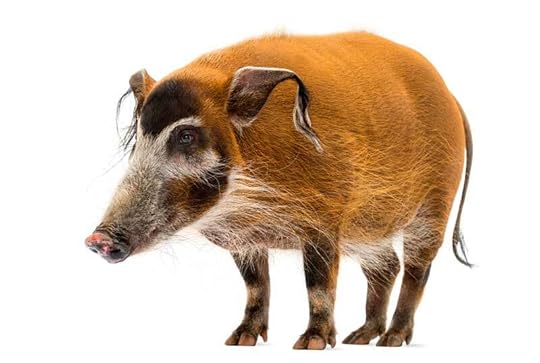
Photo Credits:
- Red river hog - DepositPhotos
These handsome hogs live in Africa, particularly in the rainforests of Guinea and The Republic of Congo. They spend most of their time near rivers and swamps.
Red river hogs live in small groups, with one adult male, several adult females, and several young. When two groups encounter each other, the two adult males engage in a dramatic confrontation. As described by zoologist Jonathan Kingdon: “Both animals strut broadside, with bristling fur and erect crests. They champ jaws, grunt, paw the soil, and whip their slender tails back and forth.”

Photo Credits:
- Red river hog - DepositPhotos
Published on March 13, 2023 18:56
March 9, 2023
Awesome Animal Fact - Diverse Ostriches
Did you know there are two living species of ostriches, but there are at least thirteen ostrich species that are now extinct? The two living species are the common ostrich and the Somali ostrich. Within the common ostrich species, there are four subspecies, one of which went extinct in the 1940s (the Syrian ostrich).
The Somali ostrich, sometimes called the blue-necked ostrich, used to be considered the same species as the common ostrich, but in 2014 mitochondrial DNA studies showed that the Somali ostrich is different enough to be considered a separate species.
By the way, contrary to popular belief, ostriches do not bury their heads in the sand to escape predators. Seriously... if they did, they wouldn't have survived millions of years, right? This myth probably started when people saw ostriches rotating the eggs in their nests. Ostriches can't make their nests in trees, so they make their nests in the sand. To make sure the eggs are evenly heated, they periodically put their heads into the nest to rotate the eggs, which might make it look like they’re trying to hide.
Below are the two living ostrich species. Notice the blue color of the neck of the Somali ostrich (on the left).

Photo Credits:
- Somali ostrich - DepositPhotos
- Common ostrich - DepositPhotos
The Somali ostrich, sometimes called the blue-necked ostrich, used to be considered the same species as the common ostrich, but in 2014 mitochondrial DNA studies showed that the Somali ostrich is different enough to be considered a separate species.
By the way, contrary to popular belief, ostriches do not bury their heads in the sand to escape predators. Seriously... if they did, they wouldn't have survived millions of years, right? This myth probably started when people saw ostriches rotating the eggs in their nests. Ostriches can't make their nests in trees, so they make their nests in the sand. To make sure the eggs are evenly heated, they periodically put their heads into the nest to rotate the eggs, which might make it look like they’re trying to hide.
Below are the two living ostrich species. Notice the blue color of the neck of the Somali ostrich (on the left).

Photo Credits:
- Somali ostrich - DepositPhotos
- Common ostrich - DepositPhotos
Published on March 09, 2023 07:34
March 5, 2023
Awesome Animal Fact - Poopy Penguins
Did you know there is a common myth that 3% of the glaciers of Antarctica consist of penguin pee? Yep, it's all over the internet... just Google it. The problem is, penguins are birds, and birds do not pee. That's right, birds do not urinate. They do not have a bladder or urethra. Instead of turning waste into urea, birds turn it into uric acid and secrete it along with their poop, which is a white paste. This is true of all birds.
So, no... Antarctica is not 3% penguin pee!
But wait! Forget the pee. What about penguin poop? Over thousands of years, penguins can produce a huge amount of poop. One scientist anecdotally estimated that penguins on Danco Island (home to between 500 and 1,000 gentoo penguins) produce about 3,000 pounds of poop per year. Over 5,000 years, that would be 15 million pounds of poop.
Is that important? Sure, because all that poop transports nutrients from the ocean to the land. But could penguin poop possibly make up 3% of Antarctica? I should point out that Antarctica covers 14.2 million square km. Wow, that's really huge. And that's only the surface—remember that the ice of Antarctica is really deep. So, 3% of the surface would be a whopping 426,000 square km. Then multiply that by, say... 100 meters deep.
Picture it: a pile of penguin poop 100 meters deep covering an area of 426,000 km. That's how much penguin poop it would take to make up 3% of the ice of Antarctica.
Okay, I admit there's a lot of penguin poop. In fact, it can be seen from space! Biologists can use satellite images to spot the poop to map penguin colonies (see the pinkish-brown poop in the Google Earth image below).
I'll let you decide if this poop could make up 3% of the entire landmass of Antarctica (I'm a bit skeptical).

So, no... Antarctica is not 3% penguin pee!
But wait! Forget the pee. What about penguin poop? Over thousands of years, penguins can produce a huge amount of poop. One scientist anecdotally estimated that penguins on Danco Island (home to between 500 and 1,000 gentoo penguins) produce about 3,000 pounds of poop per year. Over 5,000 years, that would be 15 million pounds of poop.
Is that important? Sure, because all that poop transports nutrients from the ocean to the land. But could penguin poop possibly make up 3% of Antarctica? I should point out that Antarctica covers 14.2 million square km. Wow, that's really huge. And that's only the surface—remember that the ice of Antarctica is really deep. So, 3% of the surface would be a whopping 426,000 square km. Then multiply that by, say... 100 meters deep.
Picture it: a pile of penguin poop 100 meters deep covering an area of 426,000 km. That's how much penguin poop it would take to make up 3% of the ice of Antarctica.
Okay, I admit there's a lot of penguin poop. In fact, it can be seen from space! Biologists can use satellite images to spot the poop to map penguin colonies (see the pinkish-brown poop in the Google Earth image below).
I'll let you decide if this poop could make up 3% of the entire landmass of Antarctica (I'm a bit skeptical).

Published on March 05, 2023 06:51
March 1, 2023
Awesome Animal Fact - Proud Caracal
Okay, this is my final post about cute wild cats. Seriously, it's time to hit the paws button on this theme before it becomes cat-astrophic!
Did you know the caracal has long ear tufts that it shakes at other caracals as a way of communicating? These cats, when interacting with each other, often move their heads side to side, making the ear tufts jiggle rapidly. As far as I can tell, no one knows yet what this ear-jiggling signal actually means.
One could argue that the caracal is one of the most beautiful of the wild cats. And the cats seem to know this because they often stand or sit in a rather proud, aristocratic pose.
Caracals live in Africa and the Middle East and are well adapted for dry, harsh environments, even deserts. Medium sized cats, they weigh 15 to 44 pounds (7 to 19 kg).
In ancient Egypt, caracals were religiously significant, often depicted in paintings and sculptures. For hundreds of years, in Persia (now Iran) and India, caracals were used by humans for hunting birds. They were even released into arenas with flocks of pigeons so people could bet on which caracal would kill the most pigeons. This is the origin of the expression "to put the cat among the pigeons."

Photo Credits:
- Caracal - DepositPhotos
Did you know the caracal has long ear tufts that it shakes at other caracals as a way of communicating? These cats, when interacting with each other, often move their heads side to side, making the ear tufts jiggle rapidly. As far as I can tell, no one knows yet what this ear-jiggling signal actually means.
One could argue that the caracal is one of the most beautiful of the wild cats. And the cats seem to know this because they often stand or sit in a rather proud, aristocratic pose.
Caracals live in Africa and the Middle East and are well adapted for dry, harsh environments, even deserts. Medium sized cats, they weigh 15 to 44 pounds (7 to 19 kg).
In ancient Egypt, caracals were religiously significant, often depicted in paintings and sculptures. For hundreds of years, in Persia (now Iran) and India, caracals were used by humans for hunting birds. They were even released into arenas with flocks of pigeons so people could bet on which caracal would kill the most pigeons. This is the origin of the expression "to put the cat among the pigeons."

Photo Credits:
- Caracal - DepositPhotos
Published on March 01, 2023 16:38
February 25, 2023
Awesome Animal Fact - Tiny Black-footed Cat
Yes, I'm STILL featuring obscure wild cats...
Did you know the black-footed cat is Africa's smallest wild cat? Weighing only 2.2 to 5 pounds (1 to 2.4 kg), these tiny cats look similar to domestic house cats, though they are only half the size of house cats.
These cats may be small, but they are amazingly fierce and energetic hunters, often walking over 22 miles (35 km) in a single night in search of prey. Biologists who have studied these cats consider them to be the deadliest cats in the world, with a success rate of 60%, meaning they successfully catch and kill 60% of the prey animals they pursue. Lions have a success rate of only 20 to 25%. As one scientist stated, "In one night, a black-footed cat kills between 10 and 14 rodents or small birds, averaging a kill about every 50 minutes."
Where these cats live in South Africa they are often called miershooptier, which is Afrikaans for "anthill tiger." They get this name because, during the day, they often rest in hollow termite and ant mounds.
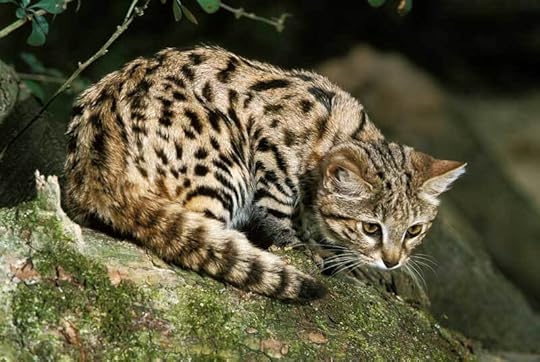
Photo Credits:
- Black-footed cat - DepositPhotos
Did you know the black-footed cat is Africa's smallest wild cat? Weighing only 2.2 to 5 pounds (1 to 2.4 kg), these tiny cats look similar to domestic house cats, though they are only half the size of house cats.
These cats may be small, but they are amazingly fierce and energetic hunters, often walking over 22 miles (35 km) in a single night in search of prey. Biologists who have studied these cats consider them to be the deadliest cats in the world, with a success rate of 60%, meaning they successfully catch and kill 60% of the prey animals they pursue. Lions have a success rate of only 20 to 25%. As one scientist stated, "In one night, a black-footed cat kills between 10 and 14 rodents or small birds, averaging a kill about every 50 minutes."
Where these cats live in South Africa they are often called miershooptier, which is Afrikaans for "anthill tiger." They get this name because, during the day, they often rest in hollow termite and ant mounds.

Photo Credits:
- Black-footed cat - DepositPhotos
Published on February 25, 2023 06:51
February 21, 2023
Awesome Animal Fact - Asian Golden Cat
Still looking at interesting wild cats.
Did you know the ASIAN GOLDEN CAT is called the fire tiger in Thailand? Legend has it that, if a village burns some of this cat's fur, it will drive tigers away from the village. Some people believe that carrying around a single hair from an Asian golden cat will keep tigers away.
Asian golden cats, which have beautiful white markings on their faces, live in Southeast Asia and China. These cats are most closely related to the bay cat and the marbled cat, two additional species that many people have never heard of.
In China, people mistakingly assume these cats are a type of leopard, and they sometimes call it a yellow leopard. Asian golden cats can have many different shades of fur, which has resulted in a variety of other names. Those with black fur are inky leopards, and those with spotted fur are sesame leopards.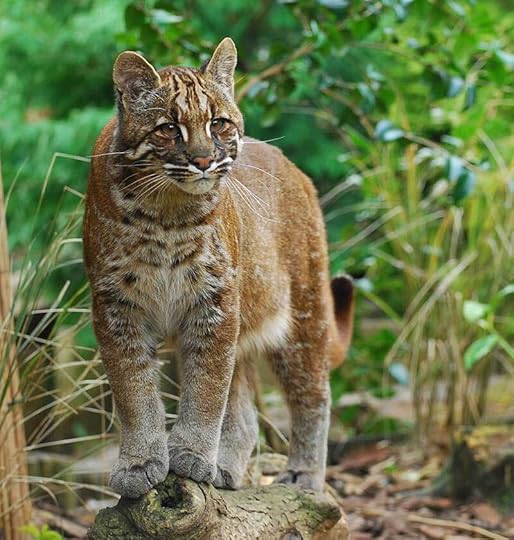
Did you know the ASIAN GOLDEN CAT is called the fire tiger in Thailand? Legend has it that, if a village burns some of this cat's fur, it will drive tigers away from the village. Some people believe that carrying around a single hair from an Asian golden cat will keep tigers away.
Asian golden cats, which have beautiful white markings on their faces, live in Southeast Asia and China. These cats are most closely related to the bay cat and the marbled cat, two additional species that many people have never heard of.
In China, people mistakingly assume these cats are a type of leopard, and they sometimes call it a yellow leopard. Asian golden cats can have many different shades of fur, which has resulted in a variety of other names. Those with black fur are inky leopards, and those with spotted fur are sesame leopards.

Published on February 21, 2023 15:12
February 18, 2023
Awesome Animal Fact - Long Jaguarundi
Still looking at interesting wild cats!
Did you know the cat called the jaguarundi is so elongated that it is often called the otter cat? These cats, only slightly larger than the average domestic cat, weighing 7.7 to 15.5 pounds (3.5 to 7 kg), have extremely long necks, small ears, elongated bodies, and long tails. They're just all-around long!
Jaguarundis live from southern Mexico, through Central America, into South America. Although much smaller, they are most closely related to the puma (also known as the mountain lion or cougar).
Jaguarundis are mostly active during the day, and they hunt a variety of small animals. In spite of their small size, these cats have been observed jumping up to two meters (6.7 feet) in the air to catch birds. Although jaguarundis usually live alone, they have an impressive range of 13 different vocalizations for communicating with other individuals. They are good climbers and swimmers, but they prefer hunting on the ground.
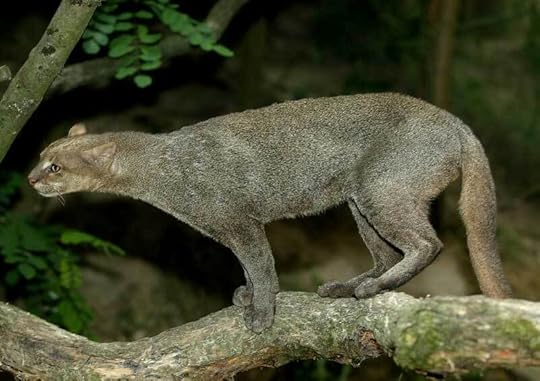
Photo Credits:
- Jaguarundi - DepositPhotos
Did you know the cat called the jaguarundi is so elongated that it is often called the otter cat? These cats, only slightly larger than the average domestic cat, weighing 7.7 to 15.5 pounds (3.5 to 7 kg), have extremely long necks, small ears, elongated bodies, and long tails. They're just all-around long!
Jaguarundis live from southern Mexico, through Central America, into South America. Although much smaller, they are most closely related to the puma (also known as the mountain lion or cougar).
Jaguarundis are mostly active during the day, and they hunt a variety of small animals. In spite of their small size, these cats have been observed jumping up to two meters (6.7 feet) in the air to catch birds. Although jaguarundis usually live alone, they have an impressive range of 13 different vocalizations for communicating with other individuals. They are good climbers and swimmers, but they prefer hunting on the ground.

Photo Credits:
- Jaguarundi - DepositPhotos
Published on February 18, 2023 06:08
February 15, 2023
Awesome Animal Fact - Water-loving Flat-headed Cat
Continuing with the theme of Ridiculously Cute Wild Cats...
A few days ago I posted about the fishing cat. Speaking of cats that eat fish, did you know the FLAT-HEADED CAT, which is smaller than an average domestic house cat, also specializes in catching fish? It even has extra-long, backward-curving teeth to help it hold on to slippery, wriggling fish.
Flat-headed cats get their name from having an unusually flattened forehead and tiny ears. They have very short legs, and a tail that's only half the length of an average domestic cat's tail. One of the smallest wild cats, flat-headed cats weigh only 3.3 to 5.5 pounds (1.5 to 2.5 kg).
An endangered species, the flat-headed cat lives in the Thai-Malay Peninsula, Borneo, and Sumatra. These cats probably deserve the name fishing cat even more than the actual fishing cat that already has that name. Flat-headed cats eat fish almost exclusively, though they occasionally catch frogs and crustaceans. Flat-headed cats lunge into the water after their prey. When they catch a fish, they first wash it off in the water to get rid of the sand and dirt, then they carry it a few meters from the water's edge to eat it, which prevents the fish from escaping back into the water.
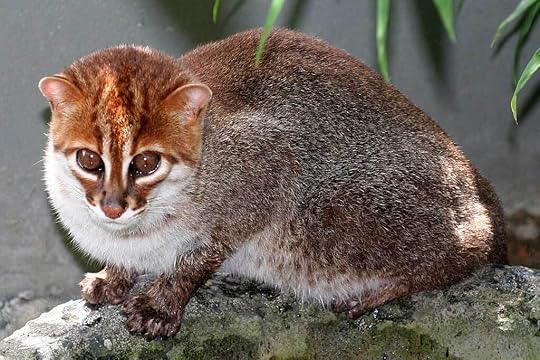
Photo Credits:
- Flat-headed cat - Jim Sanderson, CC BY-SA 3.0, via Wikimedia Commons
A few days ago I posted about the fishing cat. Speaking of cats that eat fish, did you know the FLAT-HEADED CAT, which is smaller than an average domestic house cat, also specializes in catching fish? It even has extra-long, backward-curving teeth to help it hold on to slippery, wriggling fish.
Flat-headed cats get their name from having an unusually flattened forehead and tiny ears. They have very short legs, and a tail that's only half the length of an average domestic cat's tail. One of the smallest wild cats, flat-headed cats weigh only 3.3 to 5.5 pounds (1.5 to 2.5 kg).
An endangered species, the flat-headed cat lives in the Thai-Malay Peninsula, Borneo, and Sumatra. These cats probably deserve the name fishing cat even more than the actual fishing cat that already has that name. Flat-headed cats eat fish almost exclusively, though they occasionally catch frogs and crustaceans. Flat-headed cats lunge into the water after their prey. When they catch a fish, they first wash it off in the water to get rid of the sand and dirt, then they carry it a few meters from the water's edge to eat it, which prevents the fish from escaping back into the water.

Photo Credits:
- Flat-headed cat - Jim Sanderson, CC BY-SA 3.0, via Wikimedia Commons
Published on February 15, 2023 11:10
February 13, 2023
Awesome Animal Fact - Water-loving Fishing Cat
Continuing the theme of RIDICULOUSLY CUTE WILD CATS.
Did you know the fishing cat of Southeast Asia is an excellent swimmer and is talented at catching fish? We tend to think that cats, in general, hate water, but that's not true for some cat species. The fishing cat loves water and is adapted to catching aquatic prey. They have partial webbing between their toes, and their claws do not fully retract, which helps them grab hold of slippery prey animals underwater. They also have two layers of fur, one dense layer that makes a water barrier, and a longer layer that provides the cat's spotted, camouflage appearance.
Fishing cats weigh from 11 to 37 pounds (5 to 17 kg). These cats are nocturnal and shy, so there is much about them we don't know. However, we do know they like to stand at the water's edge and swipe at fish and other aquatic animals that swim by, piercing them with their claws and then snapping them up in their jaws. Sometimes they even launch themselves headfirst into the deeper water when fish swim by farther from the shore. They eat a lot of fish this way (75% of their diet is fish), but they also eat rodents, birds, snakes, lizards, frogs, clams, snails, and insects.
Fishing cats have even been observed swimming underwater so they can grab ducks by the legs from below.
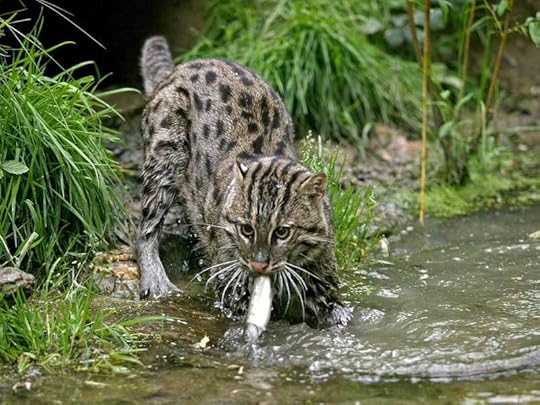
Photo Credits:
- Fishing cat - DepositPhotos
Did you know the fishing cat of Southeast Asia is an excellent swimmer and is talented at catching fish? We tend to think that cats, in general, hate water, but that's not true for some cat species. The fishing cat loves water and is adapted to catching aquatic prey. They have partial webbing between their toes, and their claws do not fully retract, which helps them grab hold of slippery prey animals underwater. They also have two layers of fur, one dense layer that makes a water barrier, and a longer layer that provides the cat's spotted, camouflage appearance.
Fishing cats weigh from 11 to 37 pounds (5 to 17 kg). These cats are nocturnal and shy, so there is much about them we don't know. However, we do know they like to stand at the water's edge and swipe at fish and other aquatic animals that swim by, piercing them with their claws and then snapping them up in their jaws. Sometimes they even launch themselves headfirst into the deeper water when fish swim by farther from the shore. They eat a lot of fish this way (75% of their diet is fish), but they also eat rodents, birds, snakes, lizards, frogs, clams, snails, and insects.
Fishing cats have even been observed swimming underwater so they can grab ducks by the legs from below.

Photo Credits:
- Fishing cat - DepositPhotos
Published on February 13, 2023 16:44
January 29, 2023
Awesome Animal Fact - Round-eyed Pallas's Cat
Continuing with the theme of RIDICULOUSLY CUTE WILD CATS.
Did you know the Pallas's cat is a small, stocky, bushy cat that lives in cold rocky areas of Central Asia? They have short legs and are slow runners. These cats have such long, thick fur that their ears are barely visible. This makes them look a little bit like domestic Persian cats. It turns out, though, that Persian cats are not derived from Pallas's cats.
Weighing 4 to 7 pounds (1.8 to 3.2 kg), the Pallas's cat (also called the manul) uses its camouflage and low body profile to hunt prey and avoid predators such as wolves, eagles, and snow leopards. Instead of chasing down their prey, these cats are ambush hunters. They often sit and wait for rodents to come out of their burrows, and often they thrust a paw into the burrow to try to snag the prey. They sometimes eat lizards and birds, but they especially like small mammals like gerbils, voles, hamsters, pikas, and small marmots.
Most cats have vertical-slit pupils, but the Pallas's cat has round pupils. Unlike domestic cats, the Pallas's cat does not meow. Instead, it growls, yelps like a small dog, and purrs.

Did you know the Pallas's cat is a small, stocky, bushy cat that lives in cold rocky areas of Central Asia? They have short legs and are slow runners. These cats have such long, thick fur that their ears are barely visible. This makes them look a little bit like domestic Persian cats. It turns out, though, that Persian cats are not derived from Pallas's cats.
Weighing 4 to 7 pounds (1.8 to 3.2 kg), the Pallas's cat (also called the manul) uses its camouflage and low body profile to hunt prey and avoid predators such as wolves, eagles, and snow leopards. Instead of chasing down their prey, these cats are ambush hunters. They often sit and wait for rodents to come out of their burrows, and often they thrust a paw into the burrow to try to snag the prey. They sometimes eat lizards and birds, but they especially like small mammals like gerbils, voles, hamsters, pikas, and small marmots.
Most cats have vertical-slit pupils, but the Pallas's cat has round pupils. Unlike domestic cats, the Pallas's cat does not meow. Instead, it growls, yelps like a small dog, and purrs.

Published on January 29, 2023 15:53



